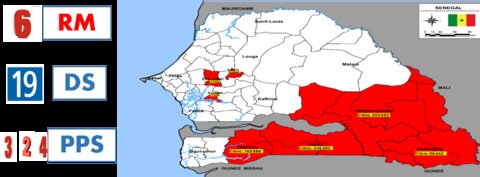Areas eligible for SMC and areas where SMC is implemented in 2021

|
Senegal 2021 SMC season |
# of children targeted |
# of children reached |
Coverage |
|
Cycle 1 |
50,763 |
47,072 |
93% |
|
Cycle 2 |
836,975 |
740,928 |
89% |
|
Cycle 3 |
836,975 |
747,844 |
89% |
|
Cycle 4 |
836975 |
754444 |
90% |
|
Children receiving at least 4 cycles |
836975 |
754444 |
90% |
Monitoring of coverage completeness

Monitoring completeness of the coverage
- Monitoring of performance indicators (evaluation of deviations)
- Quick survey
- Supervision at all levels
- Daily debriefing with regional teams
- Development of a SMC bulletin
Monitoring for compliance
- 3-day directly observed treatment across all districts
- Systematic notification on management tools
- Indirect evaluation by the refusal rate
Monitoring effectiveness
- Setting of performance indicators at all levels
- Morbi-Mortality assessment for children 0-120 months in SMC zones
- Comparison with 2018 data (year without SMC)
- Impact assessment from 2012 to 2016
Successes, opportunities, challenges and solutions in the 2020 SMC season
Successes and lessons learnt
- Holding upstream of preparatory meetings for defining roles and responsibilities for different players for the implementation of SMC
- Implementing partners can be a value added to the implementation but it is fundamental that the NMCP remains the lead (coordination and management)
- The flexibility of lenders to provide additional resources for meetings (emergency between Neema , RSS +, PMI and NMCP for support with the purchase of protective equipment, not provided for in the planning
- Sharing information early on has helped to anticipate the difficulties and arrange for better performance
- Use of platforms for coordination (alert system) in time real and between headquarters and the regional offices allowed for faster implementation.
- The right choice of community health workers and experience and capacity to intervene in their domain facilitates the work
- Training for managing undesirable effects
- Awareness before campaign facilitates community support
- The participation of local stakeholders (BG and Relais) promotes community involvement
- Maintaining safety stock avoids stock-outs and delays.
- Timely Delivery is required.
- Notification of effects undesirable on the cards, and in SMC model, facilitates transmission to Pharmacovigilance center for accountability
- Improved notification by DOT approach
- Digital app for managing undesirable effects
- The commitment of administrative authorities, nuns and elected officials in some districts facilitated implementation.
Challenges
- Starting communication on SMC 1 month before implementation
Developing a map of case refusals in districts and regions concerned - Revise the budget envelope to adapt it to the covid-19 context
- Make physical inventories of medication, after each cycle, to allow for a good estimate of needs at next cycle
Research priorities for 2020
- Study on the evaluation of the performance of 3 CPS doses in children aged 3-120 months in the regions concerned
- Cost-effectiveness analysis of SMC using a Directly observed Therapy (DOT) method for 3 days "
Partners
- OPT-SMC